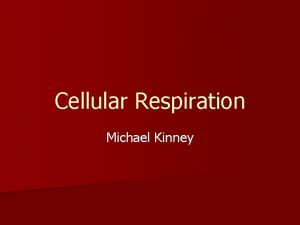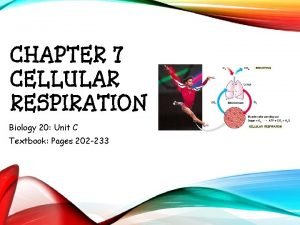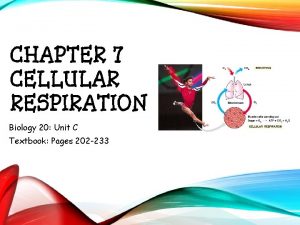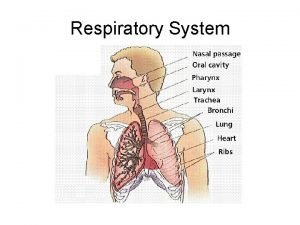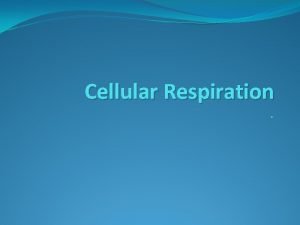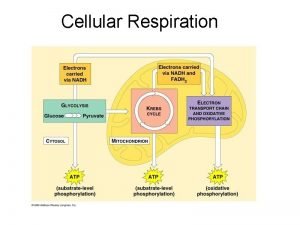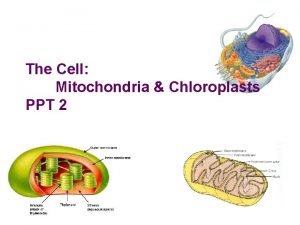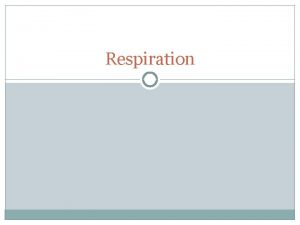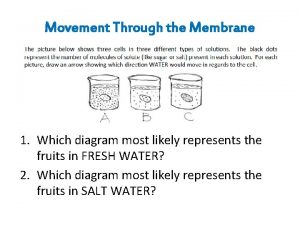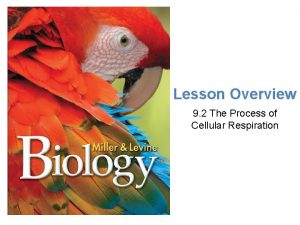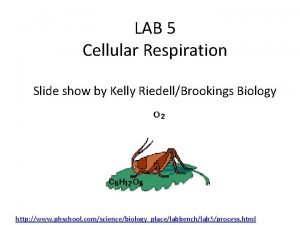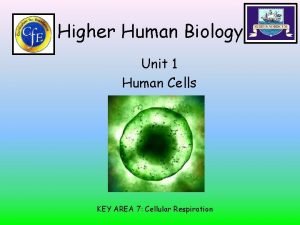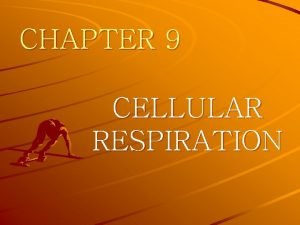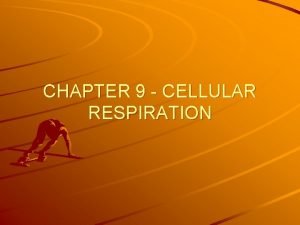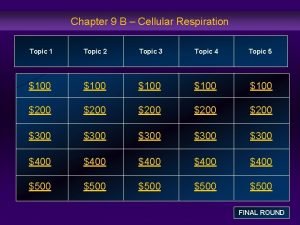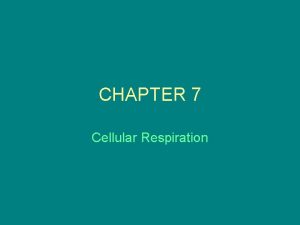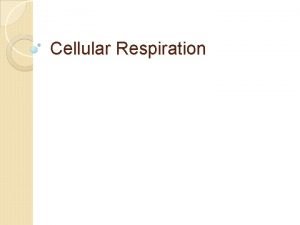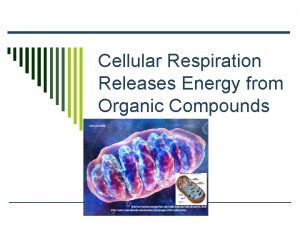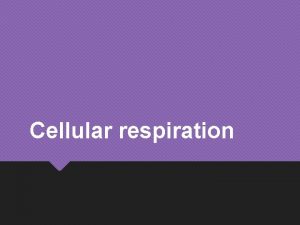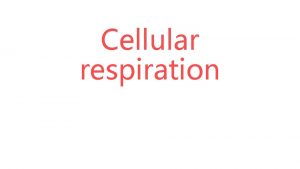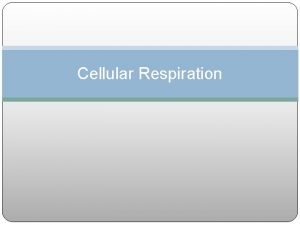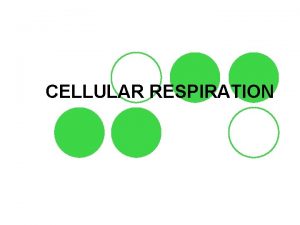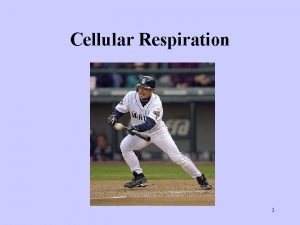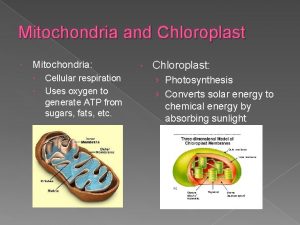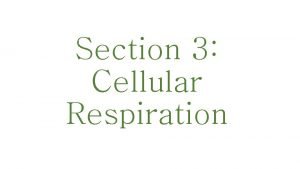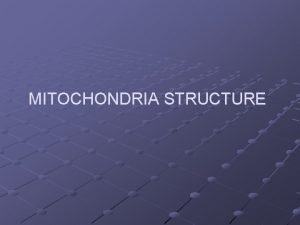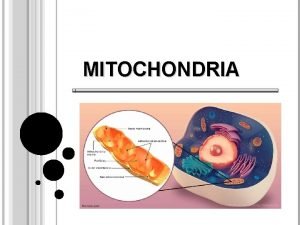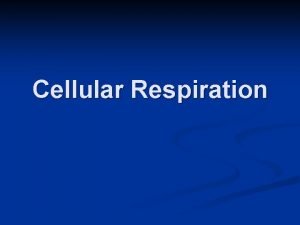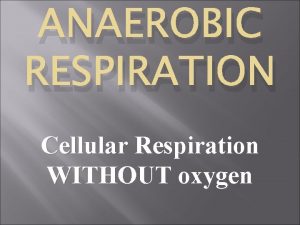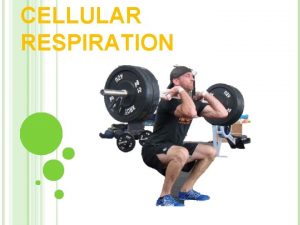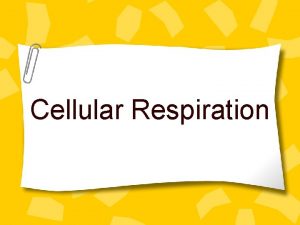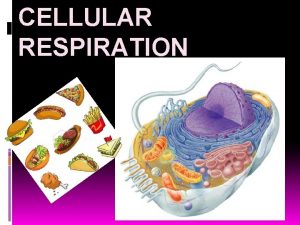Respiratory System Cellular Respiration Occurs in the Mitochondria


































- Slides: 34

Respiratory System

Cellular Respiration Occurs in the Mitochondria Release of energy from breakdown of food (glucose) Occurs in the presence of oxygen

Organism Respiration • Occurs in the Lungs • Moves O 2 into body tissues (needed for cellular respiration) • Removes CO 2 from cells/tissues

Function Exchange of oxygen and carbon dioxide between the: Blood Air Tissues

Components Nose Pharynx Epiglottis Larynx Trachea Bronchus Bronchiole Alveoli Diaphragm

Nose The nose warms and moistens the air. Nose hairs filter large dust particles. Aids in smelling.

Pharynx The pharynx serves as a passageway for both air and food.

Epiglottis A flap of cartilage tissue that prevents food from entering the trachea.

Larynx AKA voice box. Involved in breathing, sound production and prevents food from entering the trachea through coughing.

Trachea AKA windpipe. Connects pharynx and larynx to the lungs. Composed of rings of cartilage.

Bronchus The trachea divides to form the right and left bronchi that travel to each of the lungs.

Bronchiole • The bronchus subdivides into smaller airway passages called bronchioles. • The bronchioles terminate into air sacs called alveoli.

Alveoli are tiny sacs at the end of the smallest airways. Exchange of O 2 and CO 2 occur here.

Diaphragm The diaphragm the major muscle of respiration.

STOP HERE!

Mechanics of Breathing Inhalation • Air inhaled • Rib cage rises up • Diaphragm contracts downward • Active process

Mechanics of Breathing Exhalation • Air exhaled • Rib cage lowers • Diaphragm relaxes and domes upward • Passive process

Movement of O 2 and CO 2 in and out of the respiratory sys.

Healthy Lungs Air entering it must be: Warmed, moistened, filtered

Healthy Lungs Nose hairs: trap large dust particles

Healthy Lungs Mucus: moistens air, traps inhaled dust or smoke particles

Healthy Lungs Cilia: hair-like structures found in the nose and airways of the resp. sys. Sweeps trapped particles and mucus away from lungs

Breathing is Controlled Breathing is controlled by the medulla oblongata

Tobacco and the Respiratory System Nicotine: • Stimulant • Increases heart rate and blood pressure • Very addictive

Carbon Monoxide Poisonous gas Blocks transport of O 2 by hemoglobin in blood Decreases blood’s ability to supply O 2 to tissues

Tar in Cigarettes Contains many cancer-causing compounds

Smoking Paralyzes Function of the Cilia Inhaled smoke particles stick to respiratory walls or enter lungs. Smoked filled mucus becomes trapped along airways.

Smoking Causes the Lining of Respiratory Tract to Swell Reduces airflow to the alveoli

Respiratory Diseases Emphysema Bronchitis Reduces life expectancy Lung Cancer

STOP HERE!


Gas Exchange at Inner surface of alveoli 1. 2. 3. 4. O 2 dissolves in moisture Diffuses across wall of air sac Enters capillary O 2 binds hemoglobin on RBC 1. CO 2 diffuses from cells/tissues to capillary 2. CO 2 carried by blood to alveoli 3. CO 2 diffuses out of blood to inner surface of alveoli 4. CO 2 exhaled out of lungs

Gas Exchange in the Lungs Gas exchange into blood occurs in the alveoli/capillaries

Hemoglobin Increases the oxygen-carrying capacity of blood (otherwise you would need 300 L of blood)
 Labeled mitochondria cellular respiration
Labeled mitochondria cellular respiration Section 7-1 glycolysis and fermentation answer key
Section 7-1 glycolysis and fermentation answer key Biology 20 unit 1 practice test
Biology 20 unit 1 practice test Stimulus for breathing
Stimulus for breathing Steps 1
Steps 1 Krebs cycle occurs in
Krebs cycle occurs in Respiration mitochondria
Respiration mitochondria Respiratory zone
Respiratory zone Cellular respiration redox
Cellular respiration redox What is the correct equation for cellular respiration?
What is the correct equation for cellular respiration? Chemiosmosis steps
Chemiosmosis steps Where is aerobic respiration located
Where is aerobic respiration located Fermentation
Fermentation Why is cellular respiration important
Why is cellular respiration important Complementary processes
Complementary processes Summary equation for cellular respiration
Summary equation for cellular respiration How are internal and external respiration alike
How are internal and external respiration alike Photosynthesis equation
Photosynthesis equation Photosynthesis recipe card
Photosynthesis recipe card What happens during glycolysis
What happens during glycolysis Overview of cellular respiration
Overview of cellular respiration Overview of respiration
Overview of respiration Cellular respiration
Cellular respiration Cellular respiration
Cellular respiration Lab bench cellular respiration
Lab bench cellular respiration What is the word equation for cellular respiration
What is the word equation for cellular respiration Higher human biology cellular respiration
Higher human biology cellular respiration Chemical equation for cellular respiration
Chemical equation for cellular respiration What are the reactants and products of photosynthesis
What are the reactants and products of photosynthesis Cellular respiration releases
Cellular respiration releases Starting materials for cellular respiration
Starting materials for cellular respiration Chapter 8 section 3: cellular respiration
Chapter 8 section 3: cellular respiration Redox reaction in cellular respiration
Redox reaction in cellular respiration Cellular respiration formula
Cellular respiration formula Role of cellular respiration
Role of cellular respiration
